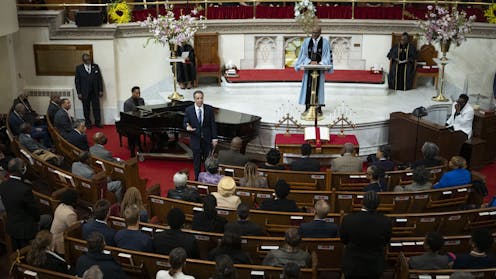Source: The Conversation – UK – By Liz Breen, Professor of Health Service Operations, School of Pharmacy & Medical Sciences, University of Bradford

Pallets don’t usually make headlines. But amid fresh controversy around the traditional July bonfires held in Northern Ireland this year, they’ve suddenly become a talking point. Wooden pallets used in these bonfires are popular due to their stacking ability, and also their colours – which include the red, white and blue of Britain.
Ordinarily, pallets are used to transport products from manufacturers to retailers. But their numbers are shrinking due to theft and loss – and of course, they cost money to buy, store, use and replace. A study by one of us (Liz) in 2006 quoted a logistics firm that estimated 14 million pallets were generally missing throughout Europe, costing £140 million. And it’s an ongoing problem: millions of products such as pallets and packaging containers are still stolen each year across the continent.
Just one bonfire in Larne, County Antrim, in July 2021 reportedly used 17,000 pallets in its construction. This year, police are investigating where the pallets used in the same community’s bonfire originated from. Amid speculation that some may belong to Australia-based supply chain firm Chep, that company has stated its pallets can never legally be bought, sold or destroyed.
Get your news from actual experts, straight to your inbox. Sign up to our daily newsletter to receive all The Conversation UK’s latest coverage of news and research, from politics and business to the arts and sciences.
Pallet losses can lead to logistical disruptions, delayed orders and bare shelves in supermarkets. And the impact is felt by pallet owners, manufacturers, customers and end-users alike.
Pallets are big business. In the US, around 513 million – mainly wooden, some plastic – are produced each year. In 2021, 48.6 million wooden pallets were produced in the UK, up 8.3% from 2020.
Rental companies can hold high numbers of pallets, which support the movement of “fast-moving” customer goods – including food, drinks and toiletries. North American firm Peco, for example, manages stock of over 20 million distinctive red wooden pallets across its 90 depots.
Manufacturers rely on pallets being available to fulfil orders and distribute them to customers quickly. Also known as “returnable transit packaging”, they are valuable assets as they can be maintained and reused. They are usually owned by a pallet pooling agent, which must absorb the loss when they are not returned from customers.
Why steal pallets?
Good-condition pallets have a resale value. Both wood and plastic pallets can be deconstructed and sold as components to other industries. Some people even use them to create furniture for homes and gardens.
Customers may feel these are legitimate upcycled products and won’t think to check where the pallets came from. However, some do have distinctive identification stamps that may remain in upcycled pallet products.
The organised theft of these products takes its toll on companies. Cargo crime (which includes consumer goods and transportation pallets and containers) is said to cost the UK economy £700 million each year.
If pallets are not available, production lines may be slowed down or stopped. And it may take longer to produce items, potentially leading to unnecessary transportation as well as greater fuel consumption and emissions.
But it can also be challenging to map pallet movements and know, at any given time, how many are in transit, with retailers, or lost. Digital tracking solutions such as radio frequency identification can be expensive to implement and are not foolproof. This can make it easy for pallets to go “missing in action”.
Pallets are a staple mechanism for stock to be received into retailers’ warehouses and distribution centres. Both the size of the pallets and their ownership can be colour-coded – at least some of the blue pallets making headlines this summer in Larne’s red, white and blue tower are thought to be owned by Chep. Warehouse bays are designed with specific pallets in mind – so changes to the pallets can bring extra costs.
Similarly, replacing lost or stolen pallets comes at a price – which could ultimately be felt by consumers if these costs are passed on by retailers.
Reducing theft and loss
Pallet owners cannot afford to continue losing them to theft. Firms that are found using non-compliant or untracked pallets because they have bought them from unauthorised sources can face shipment fines, while other initiatives, such as deposit or voucher schemes or one-for-one exchange plans, could incentivise the return of pallets.
These practices may influence corporate return behaviour, but the theft of pallets by organised crime gangs is increasing. Changing the materials used to construct pallets could reduce their financial attractiveness and resale value.
At first glance, a used pallet might look no more useful than discarded wood and be considered fair game for reuse or selling on. But businesses or individuals who collect, sell or purchase stolen pallets are putting themselves at legal risk. Firms found stockpiling or selling-on pallets without permission have faced legal action and even jail in Europe.
Aside from the legal implications, there are other operational and environmental costs. Each pallet taken out of circulation must be replaced, increasing demand for virgin timber, straining forest resources, and increasing labour costs.
The humble pallet is the backbone of global trading, and businesses rely on a steady and dependable supply. Pallet services function only if they continue to circulate – but theft and losses undermine this. Without this simple product, everyone from producers to retailers and consumers could end up paying more for the goods they take for granted.
![]()
The authors do not work for, consult, own shares in or receive funding from any company or organisation that would benefit from this article, and have disclosed no relevant affiliations beyond their academic appointment.
– ref. Pallets are the backbone of global trade but supplies are threatened by theft, loss – and giant bonfires – https://theconversation.com/pallets-are-the-backbone-of-global-trade-but-supplies-are-threatened-by-theft-loss-and-giant-bonfires-260948














